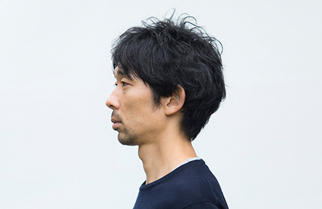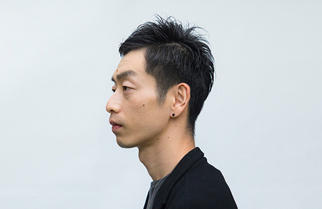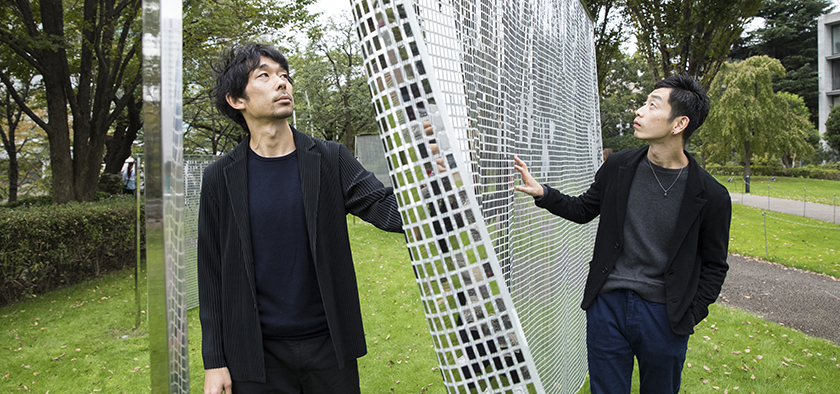
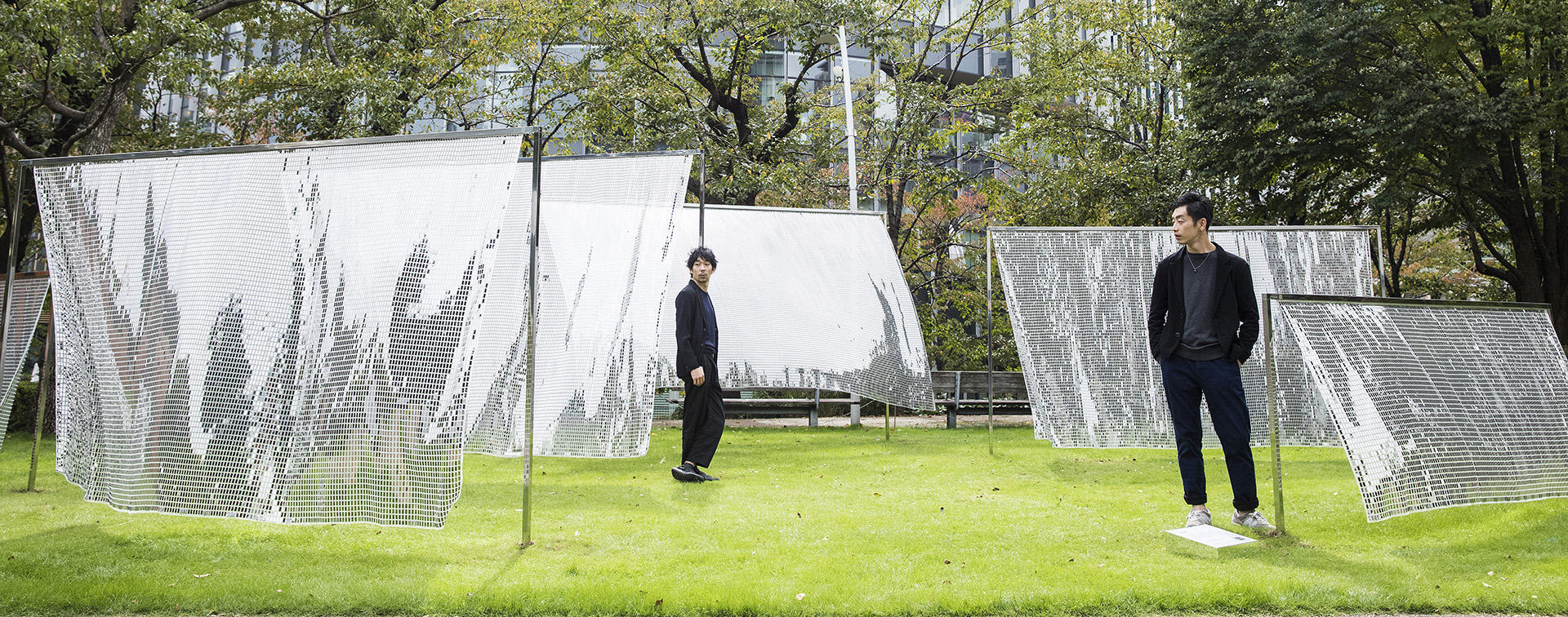
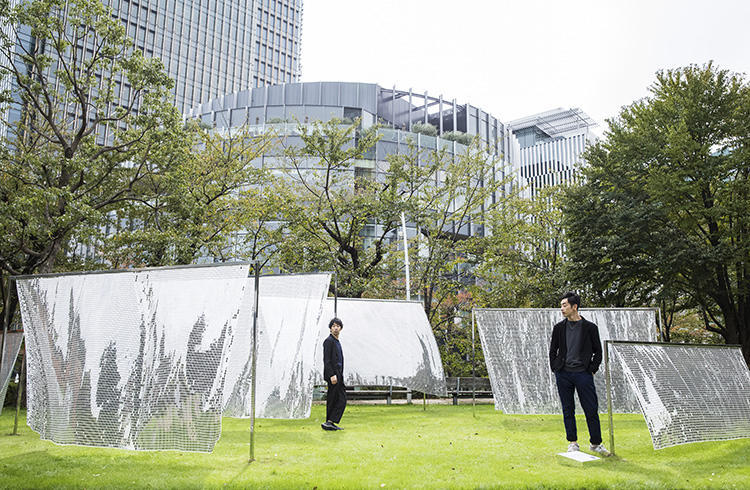
The importance of creating exhibition space for young creators
Making Roppongi a “junction” for art and design
Toshiya Hayashi and Hokuto Ando at we+, work in contemporary design – a genre that perhaps not many people are familiar with. Their works include a table on which water stain-like patterns appear and disappear, and a chair covered with steel wires that look like nails. Gaining recognition both in Japan and abroad, their simple works have a mysterious appeal which compels the viewer to gaze at them. In this interview we+ told us about how they made the installation shown at “Tokyo Midtown DESIGN TOUCH 2018” held Oct.19 (Fri) –Nov.4 (Sun) 2018, as well as about the things we can learn from the contemporary design scene overseas.
Our first experience of making an outdoor installation
AndoWe are showing the work "Swell" at "Tokyo Midtown DESIGN TOUCH 2018". It's like a big tapestry: white mesh has been covered with mirror film, and when the mesh moves in the breeze, the mirror film, reflecting the light, shines and shimmers. It's an installation that makes the wind and light visible.
HayashiThe exhibition venue is Midtown Garden and it is actually the first time for us to show an installation outdoors. When I first came to Midtown Garden, the first thing I noticed was how breezy the place was. There's a lot of greenery here, and there's even a little brook; we came up with the idea for this installation because we wanted to take advantage of the outdoor environment.
At first we thought of using water, and we tried all kinds of experiments. What we made looked nice in the evening, but it seemed as if we were not making the most of the daytime environment, and so we discarded that idea. There were some twists and turns along the way.
AndoThe venue is a place where visitors come both during the day and night, and we wanted to make a proper land art-like work which would look good at any time.
In the daytime, Swell reflects mainly natural things like sunlight and grass, and at night, it reflects things like the artificial lights in the buildings, so it looks considerably different.
We made this with the intention of making a site-specific work, and we are sure that people will be able to appreciate how different it looks in the nighttime from the daytime. Midtown Garden is a place in Roppongi where you can feel the air. Roppongi is a bustling area where communication is made at an extremely fast pace, but Midtown Garden is a unique spot of open space. We thought we could draw people's attention to the natural things like the breeze and sunlight which are in contrast with the image of Roppongi.
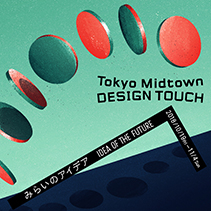
Tokyo Midtown DESIGN TOUCH 2018
Based on the concept of "enjoying design with all five senses", this event proposes ways to enrich our everyday lives by looking at everything that is a part of culture such as interior design, graphic design, product design and even music and food, from the perspective of design. The event in 2018 was themed on ideas of the future and was held Oct.19 (Fri)-Nov.4 (Sun).

"Swell"
Meaning "wave motion", it is an outdoor installation which reflects the light and moves to the wind. The two members of we+ say their wish is to give new uses to materials and allow people to see things from a slightly different perspective. This installation uses materials made by NBC Meshtec, an industrial material manufacturer, with which we+ jointly made "Peep" shown at "TOKYO MATEIRAL BYPASS" during Milan Design Week.
Showing the appealing aspect of a phenomenon in the best possible way
AndoWe've coined the term "meoki" (eye rest) and consider it a vital key word in making things. With things like bonfires and fountains, people find themselves gazing at the light or the movement of the water without thinking of anything in particular. We are interested in making things which have that kind of effect. Roppongi is a busy place but we wanted people to gaze at Swell with a blank mind: we wanted to make a work which has significance for the place.
HayashiWith all our works, we make experiments in the process of creation: we make a life-size model or a slightly smaller model to see how it would actually look. About 90 percent of the time we spend on creating a work is spent on searching for something that will resonate with everyone. To install Swell at the Design Touch event, we kept coming to check it so many times that the organizer told us, "we have never seen anyone visit the venue before the event so frequently as you have." (laughs)
With an indoor installation, there are quite a lot of adjustments we can make, such as putting up screens to control the light or making partitions in the room. However, with an outdoor installation, the environment changes so much according to the time and weather, and there are many factors we can't control. There are so many variables in our quest for the optimal solution; it's as if the eye of the needle that we want to thread is tiny. Our aim is to show the appealing aspect of a phenomenon in the best possible way, and it's more difficult to do that outdoors.

Imagining the factors that lie beyond the drawing
AndoI don't know how other creators work, but I think that if you draw a plan, make a drawing in perspective, and create according to the plan, you will usually end up with something similar to what you had in mind. But we make things that involve nature and natural phenomenon, and so, whether for good or bad, there are numerous factors beyond what we draw on paper.
We have to properly look at the physical thing in front of us and think about how we can develop it. Because we need to imagine the factors that don't appear in the drawing, experience is necessary - we need to actually see how it works. You could say that we face boundless possibilities, but the fact is that creating a work is inefficient, irrational, and rather tough.
HayashiOur process of creation is considerably analog. Once, when we made an experiment, a student working as an intern remarked, "I feel as if I've returned to my childhood days." (laughs)
AndoAt first glance, our completed works may look technological, but our process of creation is to first experiment by using our hands. Then in the final stage we incorporate engineering to carry out what we did manually, and so the technology itself is basically within the field of human physicality. Many of our works tend to be material-driven.
HayashiOften, the starting point for a work is the curiosity we have in the relationship between materials and phenomena, and the changes that occur. Rather than making visible something that is invisible, we are interested in showing the movement of materials in an entrancing way. For example, the work "Drift" uses iron sand; the sight of iron sand simply wiggling may not be very interesting, but by making iron sand move with the regular rhythm of a clock, I think we were able to give it meaningful expression.
In our works we often use everyday materials which are so common that people don't pay attention to them - materials which are overlooked but in fact can move in interesting ways.

"Drift"
A "clock" in which the iron sand is pushed by the movement of a magnet and functions as the clock hand. The viewer is lured to gaze at it since it is intriguing to watch sand - which is normally formless - move with rhythmic precision. The work was shown during Milan Design Week 2016.
The significance of continuing to exhibit during Milan Design Week
AndoWhen we exhibit overseas, people often tell us that our works are very Japanese. I suppose that our works look kind of pure, because we try to take maximum advantage of a single aspect of a phenomenon, and discard all the other factors as much as possible. But we have no intention of making anything Japanese - we just focus on how fun a certain phenomenon can appear.
HayashiThe first time we received such comments, I wondered whether our works would be more popular overseas if we tried to express something characteristic of Tokyo or Japan - that was a sly thought. (laughs) Now I think that the fact we live and work in Tokyo probably seeps through our works in a way we are not conscious of; our approach itself probably leads to works that are perceived as being Japanese.
We have been exhibiting our works during Milan Design Week since 2014 for five years in a row. This year, we presented a work called "Peep." I have a feeling that we're being gradually recognized in the design world overseas. The scene in the design world abroad is totally different from Japan. Participating every year in an overseas event allows us to do a fixed-point observation; it's good that we can see the latest trends firsthand.
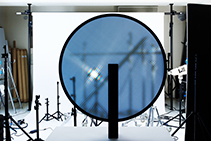
"Peep"
A work that was exhibited at "TOKYO MATERIAL BYPASS" held during Milan Design Week in 2018. The installation features a functional mesh - normally used for medical filters and for silk-screen printing plates - which disperses light and creates moiré patterns. The viewer is invited to look through the mesh and experience "a different world."
Photo: Masayuki Hayashi
AndoI agree that being able to do the fixed-point observation is very meaningful. We can get an objective view of how our works are being perceived. Of course, exhibiting in Japan leads to some kind of feedback and allows us to see fairly objectively, but the feedback we get abroad is easier to understand, and I feel that we are able to get a clearer view.
People are straightforward about whether they think a work is good or bad. Whatever the background of the creator, they will properly give credit to what they think is a good piece of work. We make works to express our current thoughts or to make a statement, and it's very meaningful for us to be able to properly grasp how people perceive our works.
Contemporary design is positioned between art and design
HayashiWe see ourselves working in the genre of contemporary design, but there are probably many ways of defining contemporary design now. Our understanding is that if art and design are on opposite ends, then contemporary design is positioned around the middle.
The things we create start from design - everything is design-based. We try to give our works functionality just as chairs and tables are functional. In design, it's necessary to make things that are linked to society in many ways, and it's important that they sell.
On the other hand, art has the strength to pose questions to society; in many cases, people make art with the simple urge to make what they want, regardless of whether it is marketable or rational. The things we make have function, so they are works of design in that sense, but we put aside the notions of marketability and rationality and explore what kinds of expressions we can come up with. For us, that is what contemporary design is about.
AndoSome of our works are apparently seen as being very much like art, but to be honest, I don't feel that is the way our works should be perceived. The people before us have created a long history of design, and we are working in that context - we are carefully designing to create ideal forms or to update the things that already exist.
Of course, art has its own history and context; to put it plainly, there are rules to art, but we don't have a structured understanding of that - it's not something we have digested. We don't take any kind of position toward art; what we make is just design-based. So we can't call ourselves artists - that would feel disrespectful to real artists...
HayashiThat certainly would not feel right. It's important, particularly overseas, to communicate what kind of statement we have. Looking at the design world in Europe and New York, it seems as if there is a separate economy revolving around people doing contemporary design - perhaps this is because there are many players in the industry. Galleries that specialize in contemporary design are not rare; works are actually sold through galleries like works of art.
Last year, we exhibited a work called "Disguise" at Roppongi Art Night. There doesn't seem to be any particular difference in the way people in Japan and overseas respond to our works; for instance, they will look and be surprised in much the same way. But the Japanese don't yet think of our works as being furniture; they just say, "What's this?" "Interesting" and that's it.
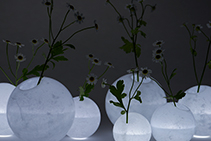
"Disguise"
Flower vases which look as if they are made of washi paper, but which have actually been shaped from many layers of wax. Subtle vibrations create ripples in the water inside, and the movements are reflected on the surface of the vases. Exhibited at Roppongi Art Night 2017.
Photo: Masayuki Hayashi
AndoIn Europe for example, a proper criteria exists for appreciating contemporary design. Because the standards are established, the people there seem to have a structured understanding of what we are trying to create in the field of contemporary design.
Japan doesn't have a long history of contemporary design, and the number of players creating things in this genre seems to be extremely few.
HayashiThe market itself is not very big, so at the moment, perhaps there are not many people who can appreciate contemporary design in a structured way.
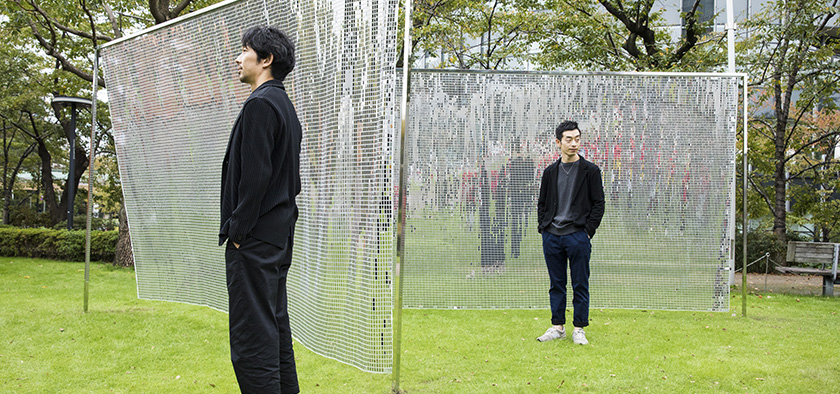
Expanding the role of design
AndoIn the last 20 years or so, the criteria for media art seems to have been gradually established, but the criteria for installations is still not concrete - as is the case with contemporary design. There is no clear definition for installations, and because of the lack of context, it's difficult to decide whether something is good or bad. I think it's very important to make things based on an understanding of context, but no clear context exists yet.
HayashiNonetheless, some kind of context is necessary when we show works in galleries, so our stance is to create things that are simply fun. Our motive, in its purest form, is to find and show phenomena that inspires everyone.
AndoThat is certainly our primary motive. That is what gives strength to a work; you end up with a flimsy piece of work if you pursue context too much. On the other hand, a work may have an interesting form, but it would also be flimsy if there is no concept or logic behind it.
My hope is that by working in contemporary design, we will be able to make new designs and expand possibilities. The role of design ought to be made increasingly bigger. There are so many new possibilities that are lying about all over the place, and I feel that if we could give them shape, more new designs will be used in society and lead to a better future.
Our role, as players in contemporary design, is to create such things, and it would be ideal if people such as curators could expand the field.
A permanent place in Roppongi to show the works of young creators
HayashiEvents such as Roppongi Art Night help to expand the field, but I think the problem in Tokyo is that places for young creators to show their works is extremely limited. In Berlin for example, there are many such places, and it's not unusual for individuals to apply for exhibiting their works while getting subsidies from the government.
I'm sure setting up exhibition spaces would be possible in Tokyo Midtown and Roppongi Hills. It would be great if there were more places which constantly showed works - places which could become gateways for careers, and where creators could gain prestige. Such places would become talked about, and attract more visitors. Aside from events that are held for only a limited period of time, I think Roppongi would become more like an area of art if there were several places that always exhibited works.
AndoRoppongi and other areas in Tokyo are becoming increasingly large and homogenized, and it will probably become more important for places to have distinctiveness. I suppose the keywords to describe Roppongi's distinctiveness are variety and diversity; to enhance its distinctiveness, I think Roppongi should be given a bigger function to serve as a sort of junction in Tokyo.
As designers, we showed our works at Roppongi Art Night. If there is such a thing as a boundary between art and design, then I wish people on either side of the boundary could step into the opposite side, so that a fusion can occur, making Roppongi filled with even more diversity. If Roppongi could become like a hub or a junction, with people from a much diverse range of genres freely coming and going, I think the place would become even more fascinating.
Editor's thoughts
Ando-san told us, "The other day, we bought a lot of super balls (bouncy rubber balls) and spent a long time observing how they bounced on the floor." My initial impression was that their works were very technological, but Ando-san said the way they conceive ideas and make their works is analog. "When I was a student, I thought designers worked in a much cooler way," he said laughingly. It is no doubt their boyish curiosity and love of experiments which enable them to make such appealing works. I would like to keep track of their activities and see how their activities in contemporary design will breathe new life into the worlds of art and design. (text_ikuko hyodo)




